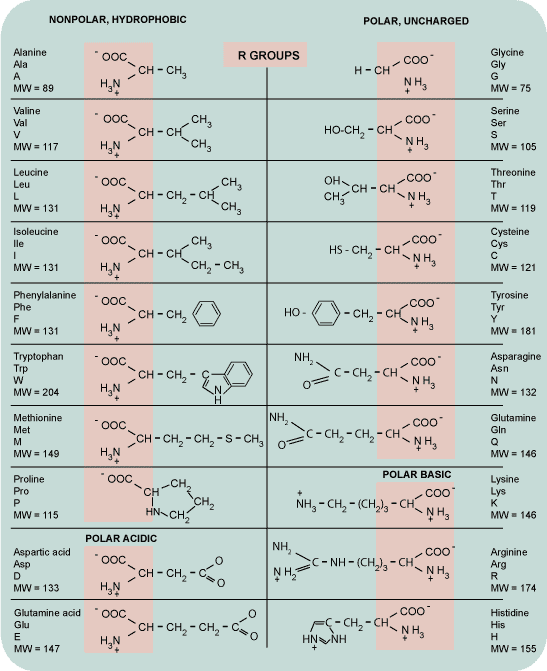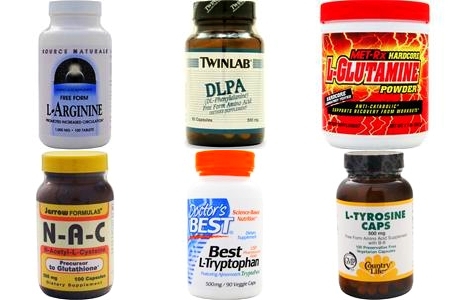Amino Acid Supplement Guide
Amino acids are among the most useful and unique nutritional supplements, but they’re not as familiar to most people as vitamins and minerals. Although some amino acids are essential nutrients like vitamins and minerals, amino acid supplements aren’t used the same way. Instead, people use amino acids for their specific and specialized effects on the mind and body. In this blog post, we’ll do a quick rundown of the most common types of and uses for amino acid supplements. There’s a good chance you could benefit from one or several.
What are amino acids? Amino acids are natural compounds found in all living things. Of the many types of amino acids in nature, there are 20 types used by the human body. Of these, 8 must be obtained from food because, like vitamins and minerals, they cannot be made by the body. These are the 8 essential amino acids.

Humans use 20 different amino acids; each has unique properties and benefits.
In general, the body uses amino acids as building blocks to make larger compounds called proteins. We obtain the amino acids we need by breaking the protein we eat back down to the amino acid level.
Each protein is a unique 3-D arrangement of specific amino acids. Proteins range in size from just a few amino acids to thousands of amino acids. There is an almost infinite variety of available combinations to make proteins, just as the 26 letters of the alphabet can be arranged to form an infinite variety of words, sentences and paragraphs. There are hundreds of different proteins used by the body for all kinds of purposes. Protein constitutes much of the body’s physical structure. Protein is also needed to make the hormones and enzymes that regulate and control body functions.
It’s not incorrect to say that humans require protein, but it’s more accurate to say that we need amino acids. Because when we eat protein foods like fish or meat, we don’t actually absorb that protein. Instead, the protein is broken down into individual amino acids. We absorb the individual amino acids and use them to build the proteins we need “from scratch”.
Amino acid supplements usually contain free-form amino acids; amino acids in a pure form, unattached to other amino acids as they are in protein foods. Most amino acids can occur in one or two mirror-image configurations, an L form and a D form. With few exceptions, the L form is the form the human body uses, so some products.
Apart from being mere building blocks, though, each amino acid also has unique and specialized functions, and people take amino acid supplements for these specific properties. Here’s a breakdown of the most common types of amino acids and the benefits and properties for which people use them.
Arginine: Arginine supplements are used for two main benefits. The first has to do with circulation. Arginine is used by the body to make nitric oxide (NO) which induces relaxation and widening of blood vessels. So arginine supports everything from healthy blood pressure, to erectile function to bigger muscle pumps when weight training. Less commonly, arginine is taken to increase HGH (human growth hormone) release during sleep.
In some individuals prone to herpes outbreaks, high doses of arginine can induce and outbreak. Lysine supplements, taken several hours before or after arginine, may help lessen the tendency of arginine to induce a herpes outbreak.
Alanine: In the form of beta-alanine, the real reason people use alanine isn’t alanine, it’s carnosine. Carnosine is a dipeptide (it consists of paired amino acids; alanine and histidine) with some very interesting properties and people use alanine/carnosine supplements for 2 main reasons. Carnosine increases muscular output and delays fatigue so it’s great for athletes and strength trainers. Carnosine also has some anti-aging properties due to it’s ability to inhibit the formation of harmful sugar-protein complexes that accelerate aging and damage tissues. But taking carnosine isn’t as effective as taking the precursors alanine and histidine, since carnosine can be broken down either during digestion or even after being absorbed intact.
Asparagine: Asparagine is a non-essential amino acid, not used or widely available as a supplement.
Aspartic acid: Aspartic acid is a non-essential amino acid, not used or widely available as a supplement.
Cysteine: As L-cysteine, it’s usually used to support healthy hair growth. In the form of N-acetyl-cysteine, it’s used as an antioxidant/detoxification agent in the liver.
Glutamine/glutamic acid: This amino acid, in either form, has so many functions there’s not enough space to describe them all. Glutamine users usually have one of three things in mind. Support for muscle growth and strength, support for the immune system and and support for intestinal health. Since people usually supplement with 5 gram doses of glutamine, and since it is a tasteless white powder, it’s most practical to buy and use the powder form.
Glycine: Not many people use glycine as a standalone supplement, but when they do, it’s usually in the interest of promoting collagen production to improve the health of skin and joints.
Isoleucine: Isoleucine, leucine and valine are three essential amino acids referred to collectively as the branched chain amino acids or BCAAs. Isoleucine is rarely used by itself, much more commonly, all three BCAAs are supplement together.
Leucine: Leucine is a BCAA also used as a standalone supplement. Leucine is used to preserve muscle mass, to create and maintain a more anabolic state.
Lysine: Lysine actually has many functions, but lysine supplements are used almost exclusively the help shorten the duration and severity of some types of herpes outbreaks. Some people use daily doses of lysine to help prevent future outbreaks. Lysine, along with the amino acid proline, is also involved in the production of collagen,which helps keep joints, blood vessels, and skin supple and healthy.
Methionine: Methionine is rarely supplemented by itself as a free form amino acid. More commonly it’s metabolite SAM-e is used. SAM-e, pronounced “sammy”, is used to support a good mood, liver detoxification and joint health.
Phenylalanine: Phenylalanine first became popular after being described in Durk Pearson and Sandy Shaw’s 1981 bestseller, Life Extension: A Practical Scientific Approach. As a precursor to the neurotransmitter norepinephrine, phenylalanine can improve your mood, decrease your appetite and sharpen your mind. It can also raise blood pressure in some people, so those with hypertension should use it with caution. The DLPA form of phenylalanine is used to reduce sensitivity to pain.
Proline: When proline is used as a supplement, it’s usually to promote the formation of collagen, for healthy skin, joints and blood vessels. Proline is sometimes combined with another collagen-forming amino acid, lysine for synergistic benefits.
Serine: Serine is a nonessential amino acid rarely used as a standalone supplement.
Threonine: Threonine is an essential amino acid, but not commonly used as supplement.
Tryptophan: Tryptophan is an essential amino acid best known and used for its role as a precursor to the neurotransmitter serotonin. Increasing serotonin levels can improve mood and sleep quality, so tryptophan supplements are most often used for one or both of these purposes.
Tyrosine: Tyrosine derives its name from the Greek word for cheese, tyros, as a result of its discovery in cheese protein. Tyrosine is needed for the production of thyroid hormones an d neurotransmitter, so people use tyrosine supplements to support a positive mood and healthy metabolism.
Valine: Valine is most commonly supplemented along with the other branched-chain amino acids, isoleucine and leucine, in a BCAA supplement. One form of valine, nor-valine, is sometimes used in Nitric Oxide (NO) formulas because it may inhibit the arginase enzyme and therefore help promote better NO production.
Amino acids are totally natural and safe when use sensibly, and they have some very interesting and useful properties. But they’ve never really been used to their full potential by the supplement-buying public. Why is this? Well, because amino acids are naturally-occurring in the food supply, they cannot be patented. Because they cannot be patented in their natural forms, their profit potential as retail products is very modest especially when compared to patent-able drugs. So there has never been and never will be a major marketing campaign to brand and explain the many different benefits and unique properties of amino acid supplements. So they’ve never really gone prime time and achieved mass popularity. Which is a shame because they have some very useful properties and are very affordable.
- Posted in Miscellaneous
- No Comments




